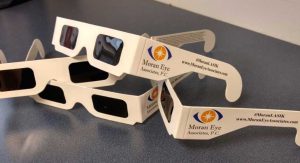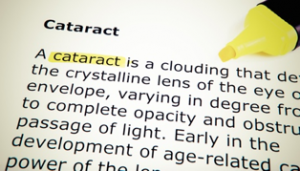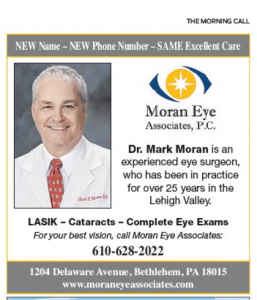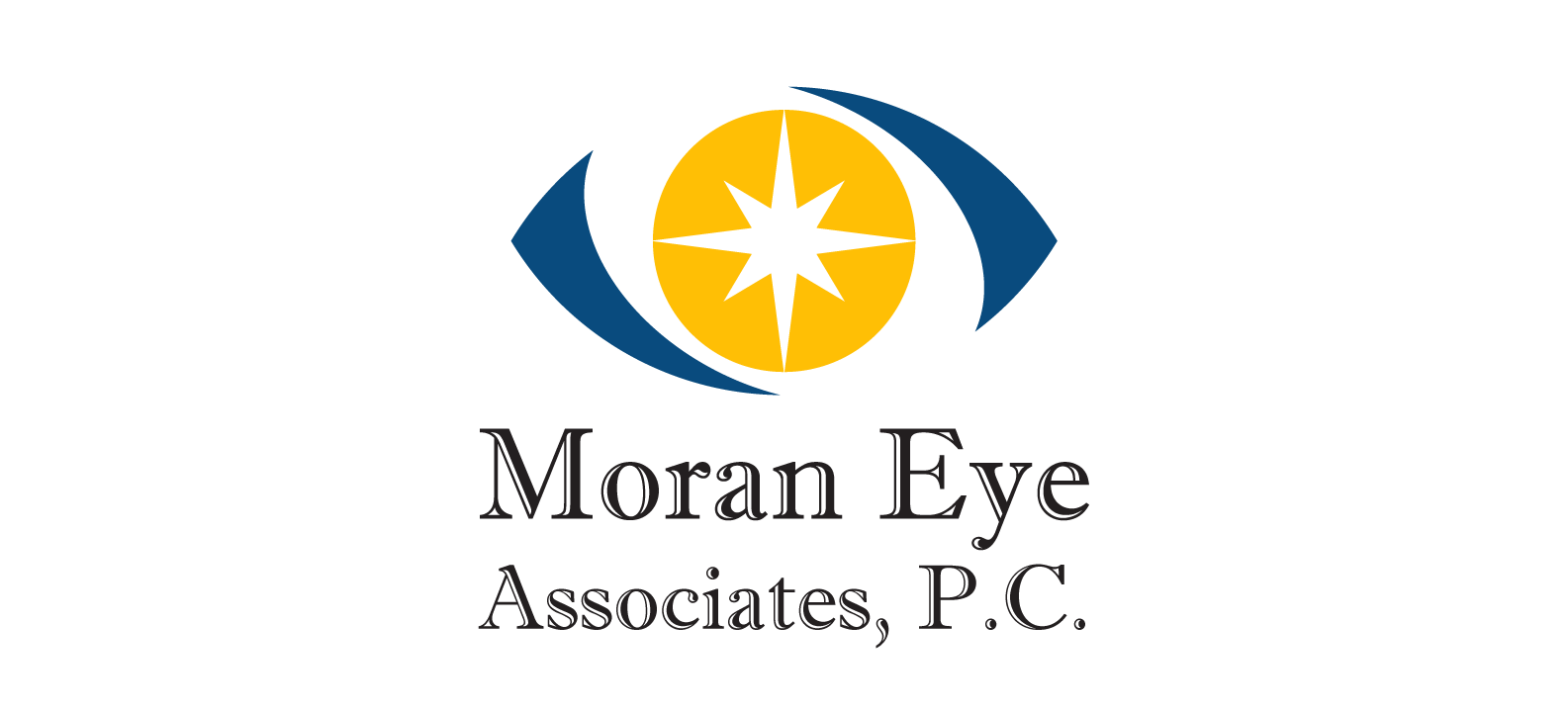by Dr. M | Sep 5, 2017 | Appointment, Education, Exam, LASIK, Medical Eye Care, Office, Patient Care
At Moran Eye Associates, patient education is a priority. Our goal is to make sure that you see clearly AND that you understand clearly as well!
Have you ever left a doctor’s office and not been completely sure about your diagnosis or treatment plan? We never want that to happen to you at our office! Dr. Moran is an expert at patient education. He makes complex medical information easy to understand by using analogies. We’ve compiled a “Best of” collection here. Our patients appreciate how he explains the sometimes confusing issues of eye care!

A peep hole in a wooden fence.
If you want to see what’s on the other side of a fence, the bigger the fence hole, the more you can see. When patients ask why they have to be dilated, this answer helps make it easier to understand. If Dr. Moran is looking through your normal pupil he/she will only see a small portion of the back of the eye. If he is looking through a dilated pupil, the hole is much bigger, and he can see much more to better evaluate the health of your eye.
Your eye is like a camera. The retina is like the film of the camera, and the eye’s lens is like the lens of the camera. In order to have good photos (clear vision), both the lens and the retina must be working well. You won’t have a good photo is there is a problem with the film…just like you won’t have a good photo if the lens is damaged.

Tear film is like rain on a windshield
Tear film is like rain on a windshield. If it is only drizzling and there is very little rain (poor tear film), your windshield will be streaky, the wipers won’t work effectively, and your vision will be blurry. If it is raining steadily (good tear film), the wipers will clear away the water effectively and your vision will be clearer. Your eye works the same way…good tear film is needed for clear vision.
You don’t need a bazooka to swat a mosquito. When Dr. Moran prescribes medicine, he chooses the right medicine for your needs. There are many options available, so it’s important to have the right dosage of the right medicine, more is not always better!

Cruise Ships turn very slowly!
Changing treatment plans is like turning a cruise ship, turn gradually and you will get you where you need to go smoothly. If you are moving from one treatment plan to another, we don’t want to make abrupt changes. Making gradual changes can help to achieve the best results.

Make sure the fire is COMPLETELY OUT!
When you put out a fire, make sure it is out completely. If you leave embers burning, it may reignite! It’s a good way to understand why you need to continue taking all of your medicine. If you stop taking it before the pain is gone, or before the infection is completely gone, your problem could start up again. Think of it like a fire that reduced to embers, it can burst into flames again!
Dr. Moran is always coming up with new and different analogies to make vision care less confusing. We’ll continue to update our patient education “best of lists” on Facebook! “Like” Moran Eye Associates us to stay informed!
Moran Eye Associates on FB
by Dr. M | Aug 23, 2017 | Cataracts, Exam, Experience, Eye Protection, Eye Safety, Glaucoma, LASIK, Macula, Medical Eye Care, Patient Care, Sun Damage, Surgery, Uncategorized

Ask the expert!
 …or as we like to call it, ask our expert, “ASK DR. MORAN”!
…or as we like to call it, ask our expert, “ASK DR. MORAN”!
Dr. Mark Moran will be featured on 100.7 WLEV’s Morning Show with Selena & Crockett each Thursday on 100.7 WLEV. He is the medical expert on the panel of Lehigh Valley professionals.
Dr. Moran was selected to be a part of “Ask the Experts,” a drive-time feature aired between 8-8:15 am weekdays. Dr. Moran will provide medical expertise on the Thursday edition of this program. He will answer questions about keeping your eyes healthy and getting the most from your vision. The Morning Show’s Kevin Crockett will ask Dr. Moran questions sent in by morning show listeners.
Our expert will answer questions about: 
- LASIK Surgery
- Dry Eyes
- Screen Time Solutions
- Your Risk factors for Eye Diseases
- Your Eyes as You Get Older – Cataracts
Patient education has always been a priority at Moran Eye Associates because Dr. Moran knows that an informed patient makes the best healthcare decisions. We invite you to listen in every Thursday for great advice on eye care.
Have a question?
If you have a question for Dr. Moran, you can send a message to the Morning Show, or email us directly with your question. Of course, we will reply to the emails sent to [email protected]. We will also pass along your inquiry to WLEV, where Crockett might read it on the air!
Mark your calendars, and be sure to listen in to Ask the Experts with Dr. Mark Moran Thursdays at 8 am!
by Dr. M | Aug 15, 2017 | Eye Protection, Eye Safety, Macula, Medical Eye Care, Patient Care, Sun Damage, UV Rays
Protect your eyes with complimentary #SolarEclipse glasses, courtesy of Dr. Mark Moran.

Solar Eclipse Glasses
Stop in at Moran Eye Associates, 1204 Delaware Avenue, Fountain Hill to pick up your pair!* Our office is open 8am-4pm, Monday-Thursday.
Post pictures of yourself in your protective specs with the hashtag #MoranLASIK. We’d love to see photos of you keeping it safe during the eclipse!
For more information on eye safety during the eclipse, click here to read an article written by Dr. Moran “Why you shouldn’t look at a Solar Eclipse”
*Limit 2 per person.
by Dr. M | Jul 23, 2017 | Eye Protection, Eye Safety, Macula, Medical Eye Care, Patient Care, UV Rays
On August 21st, 2017 the United States will see its first solar eclipse since 1979.
This eclipse will be visible to all of the continental United States, unlike the 1979 event which was seen by residents in only five northwestern states. The visible path of the 2017 eclipse will span the country.
A solar eclipse is when the new moon comes between the earth and the sun. Where you are on earth determines how much of the sun is blocked by the moon. The 2017 eclipse will have almost 3 minutes of totality (when the sun is completely blocked by the moon) and the best location to see this, is Hopkinsville, KY. At totality, the only thing that will be visible is the sun’s corona and it will be dark enough to see stars during the day. Only a small strip of the United States will experience totality as the eclipse passes overhead.
You’ve probably heard you that shouldn’t look at the sun during an eclipse. This information is true, except only at totality. If you’re in a region with 100% coverage and the moon has fully covered the sun, it is ok to look ONLY at that time. Misjudging the timing could be blinding. Since most of the United States will not be able to view the eclipse at totality, as a general rule, it is best to not look directly at the eclipse.
Most of have inadvertently glanced at the sun. We quickly close our eyes, turn away or shield our eyes. That’s your body’s natural defense to the BRIGHTNESS. But the brightness is only part of the harmful effect. The sun is essentially a thermonuclear explosion, or atom bomb, constantly exploding. This reaction is emitting harmful ultraviolet light (UV).
If you were to look at the sun at any time, your cornea will unwittingly do its job and focus that UV light right in the center of your macula. While the sun is partially blocked by the moon the brightness will be decreased, and your natural reaction to look away will be diminished. Although the sun will be less bright, the UV rays will still be as strong. These UV rays will seriously damage your macula. At totality, both the brightness and the UV rays are blocked by the moon. That is why ONLY AT TOTALITY, for those few minutes, it is OK to look at the sun when it is fully hidden behind the moon and only the corona is visible.
To safely view the eclipse, you need a special filter. The filter should have ISO certification and should be free of any pinholes or damage. Old filters should be discarded as they can lose effectiveness. Proper planning and proper viewing will ensure your eyesight and preserve it for the next United States viewable eclipse in 2024.

Eclipse fun facts:
- How does the moon which is 400 times smaller than the sun cover all of the sun? The Moon is currently conveniently located about 400 times closer than the sun.
- The Moon is slowly moving away from the Earth and it’s estimated in 1.4 billion years there will be no such thing as a solar eclipse on earth.
Photo: NASA
by Dr. M | Jun 20, 2017 | Cataracts, Exam, Medical Eye Care, Patient Care, Surgery

What is a cataract?
Most people over the age of 50 will develop cataracts at some time in their lives.
The good news is that cataract surgery is an outpatient procedure that takes just minutes to perform with a quick recovery time.
How would I know if I have a cataract? A cataract develops gradually, so you may not notice a big change in your vision from one day to the next. A cataract can easily be detected during a routine eye exam. If you are starting to notice any of the following issues, you should make an appointment with Dr. Moran.
- Glare or Halos
- Poor Night Vision
- Cloudy or Blurry Vision –
- Colors Look Faded
- Double Vision in One Eye
Many patients say that after cataract surgery they have the best vision of their lives.
During your cataract surgery, Dr. Moran will remove the cloudy lens of the eye, and replace it with a clear intraocular lens (IOL). When we take your surgery measurements you will have some choices when it comes to the type of lens implant you will have.

An Intraocular Lens is Inserted during cataract surgery to improve your vision.
You can choose:
- A Mono-focal IOL will provide you with one point of focus (like regular eyeglasses)
- A Toric IOL provides one point of focus and corrects your astigmatism.
- A Multi-focal IOL (ReSTOR) allows for a full range of vision – near, intermediate and distance – greatly reducing your need for glasses.
- A Multi-focal IOL (ReSTOR/TORIC) which allows for a full range of vision – near intermediate and distance & corrects your astigmatism.
We will talk to you about your daily life and your visual needs before we schedule your surgery. We will review your lens choice options so that you get the right lens for you. Dr. Moran will use his expertise to help you get the best outcome.
If you have questions about cataracts, contact our office for an appointment. When you are ready for cataract surgery, we will make sure that you have all the information that you need to make the best decisions for you, 610-628-2022.
To learn more go to Cataracts
by Dr. M | May 15, 2017 | Appointment, Exam, Experience, Medical Eye Care, Patient Care, Referral
 Did you see us in the Morning Call this weekend?
Did you see us in the Morning Call this weekend?
The word is spreading…for excellence in eye care, contact Moran Eye Associates.
Tell your friends & family!






 …or as we like to call it, ask our expert, “ASK DR. MORAN”!
…or as we like to call it, ask our expert, “ASK DR. MORAN”!





 Did you see us in the Morning Call this weekend?
Did you see us in the Morning Call this weekend?